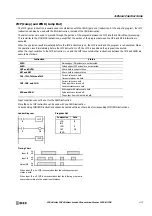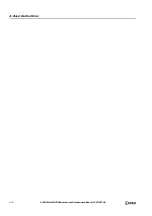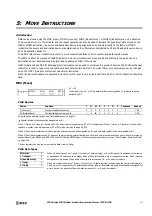
5: M
OVE
I
NSTRUCTIONS
5-6
FC6A S
ERIES
MICROS
MART
L
ADDER
P
ROGRAMMING
M
ANUAL
FC9Y-B1726
IMOV (Indirect Move)
Valid Devices
For valid device address ranges, see "Device Addresses" on page 2-1.
Special internal relays cannot be designated as D1.
When T (timer) or C (counter) is used as S1, S2, or D2, the device data is the timer/counter current value (TC or CC). When T (timer) or C (counter)
is used as D1, the device data is the timer/counter preset value (TP or CP) which can be 0 through 65,535.
When F (float) data is selected, only data register can be designated as S1 or D1.
When F (float) data is selected and S1 does not comply with the normal floating-point format, a user program execution error will result, turning on
special internal relay M8004 and ERR LED on the FC6A Series MICROSmart.
Source device S2 or destination device D2 does not have to be assigned. If S2 or D2 is not assigned, the source or destination device is determined
by S1 or D1 without offset.
Make sure that the source data determined by S1 + S2 and the destination data determined by D1 + D2 are within the valid device range. If the
derived source or destination device exceeds the valid device range, a user program execution error will result, turning on special internal relay
M8004 and the ERR LED on the FC6A Series MICROSmart. For user program execution errors, see "User Program Execution Errors" on page 3-10.
Valid Data Types
S1 + S2
→
D1 + D2
When input is on, the values contained in devices assigned by S1 and
S2 are added together to determine the data source. The 16- or 32-
bit data is then moved to the destination, which is determined by the
sum of values contained in devices assigned by D1 and D2.
REP
**
S1(R)
*****
D1(R)
*****
IMOV(*)
S2
*****
D2
*****
Device
Function
I
Q
M
R
T
C
D
P
Constant
Repeat
S1 (Source 1)
Base address to move from
X
X
X
X
X
X
X
—
—
1-99
S2 (Source 2)
Offset for S1
X
X
X
X
X
X
X
—
—
—
D1 (Destination 1)
Base address to move to
—
X
X
X
X
X
—
—
1-99
D2 (Destination 2)
Offset for D1
X
X
X
X
X
X
X
—
—
—
W (word)
X
When S1 (source 1) is a word device and D1 (destination 1) is a Q, M, or R bit device, the data is transferred as
16 points or 32 bits, depending on the data type. When repeat is assigned for a bit device, the quantity of device
bits increases in 16- or 32-point increments.
When a word device such as T (timer), C (counter), or D (data register) is assigned as the source or destination,
1 point (word data) or 2 points (double-word or float data) are used. When repeat is assigned for a word device,
the quantity of device words increases in 1- or 2-point increments.
I (integer)
—
D (double word)
X
L (long)
—
F (float)
X
Summary of Contents for MICROSmart FC6A Series
Page 1: ...B 1726 7 FC6A SERIES Ladder Programming Manual ...
Page 8: ...Preface 7 FC6A SERIES MICROSMART LADDER PROGRAMMING MANUAL FC9Y B1726 ...
Page 32: ...1 OPERATION BASICS 1 20 FC6A SERIES MICROSMART LADDER PROGRAMMING MANUAL FC9Y B1726 ...
Page 96: ...3 INSTRUCTIONS REFERENCE 3 18 FC6A SERIES MICROSMART LADDER PROGRAMMING MANUAL FC9Y B1726 ...
Page 130: ...4 BASIC INSTRUCTIONS 4 34 FC6A SERIES MICROSMART LADDER PROGRAMMING MANUAL FC9Y B1726 ...
Page 192: ...9 SHIFT ROTATE INSTRUCTIONS 9 12 FC6A SERIES MICROSMART LADDER PROGRAMMING MANUAL FC9Y B1726 ...
Page 272: ...12 DISPLAY INSTRUCTIONS 12 24 FC6A SERIES MICROSMART LADDER PROGRAMMING MANUAL FC9Y B1726 ...
Page 284: ...14 REFRESH INSTRUCTIONS 14 6 FC6A SERIES MICROSMART LADDER PROGRAMMING MANUAL FC9Y B1726 ...
Page 502: ...25 DATA LOG INSTRUCTIONS 25 22 FC6A SERIES MICROSMART LADDER PROGRAMMING MANUAL FC9Y B1726 ...
Page 546: ...26 SCRIPT 26 44 FC6A SERIES MICROSMART LADDER PROGRAMMING MANUAL FC9Y B1726 ...
Page 598: ...APPENDIX A 14 FC6A SERIES MICROSMART LADDER PROGRAMMING MANUAL FC9Y B1726 ...















































